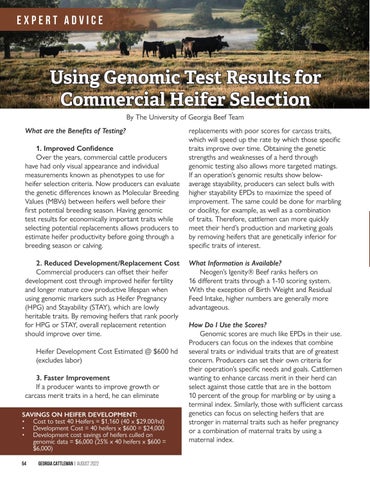Expert Advice
Using Genomic Test Results for Commercial Heifer Selection By The University of Georgia Beef Team What are the Benefits of Testing? 1. Improved Confidence Over the years, commercial cattle producers have had only visual appearance and individual measurements known as phenotypes to use for heifer selection criteria. Now producers can evaluate the genetic differences known as Molecular Breeding Values (MBVs) between heifers well before their first potential breeding season. Having genomic test results for economically important traits while selecting potential replacements allows producers to estimate heifer productivity before going through a breeding season or calving. 2. Reduced Development/Replacement Cost Commercial producers can offset their heifer development cost through improved heifer fertility and longer mature cow productive lifespan when using genomic markers such as Heifer Pregnancy (HPG) and Stayability (STAY), which are lowly heritable traits. By removing heifers that rank poorly for HPG or STAY, overall replacement retention should improve over time. Heifer Development Cost Estimated @ $600 hd (excludes labor) 3. Faster Improvement If a producer wants to improve growth or carcass merit traits in a herd, he can eliminate SAVINGS ON HEIFER DEVELOPMENT: • Cost to test 40 Heifers = $1,160 (40 x $29.00/hd) • Development Cost = 40 heifers x $600 = $24,000 • Development cost savings of heifers culled on genomic data = $6,000 (25% x 40 heifers x $600 = $6,000) 54
GEORGIA CATTLEMAN | AUGUST 2022
replacements with poor scores for carcass traits, which will speed up the rate by which those specific traits improve over time. Obtaining the genetic strengths and weaknesses of a herd through genomic testing also allows more targeted matings. If an operation’s genomic results show belowaverage stayability, producers can select bulls with higher stayability EPDs to maximize the speed of improvement. The same could be done for marbling or docility, for example, as well as a combination of traits. Therefore, cattlemen can more quickly meet their herd’s production and marketing goals by removing heifers that are genetically inferior for specific traits of interest. What Information is Available? Neogen’s Igenity® Beef ranks heifers on 16 different traits through a 1-10 scoring system. With the exception of Birth Weight and Residual Feed Intake, higher numbers are generally more advantageous. How Do I Use the Scores? Genomic scores are much like EPDs in their use. Producers can focus on the indexes that combine several traits or individual traits that are of greatest concern. Producers can set their own criteria for their operation’s specific needs and goals. Cattlemen wanting to enhance carcass merit in their herd can select against those cattle that are in the bottom 10 percent of the group for marbling or by using a terminal index. Similarly, those with sufficient carcass genetics can focus on selecting heifers that are stronger in maternal traits such as heifer pregnancy or a combination of maternal traits by using a maternal index.













